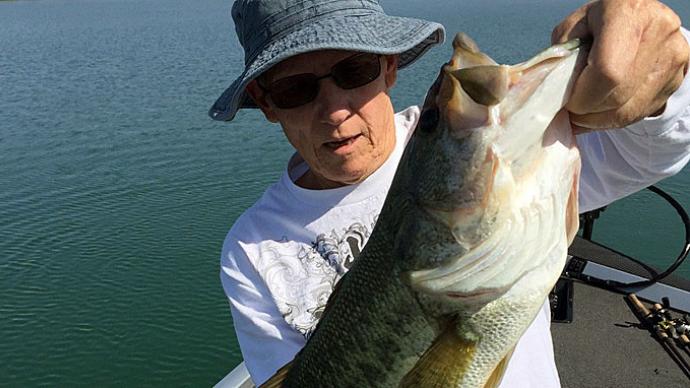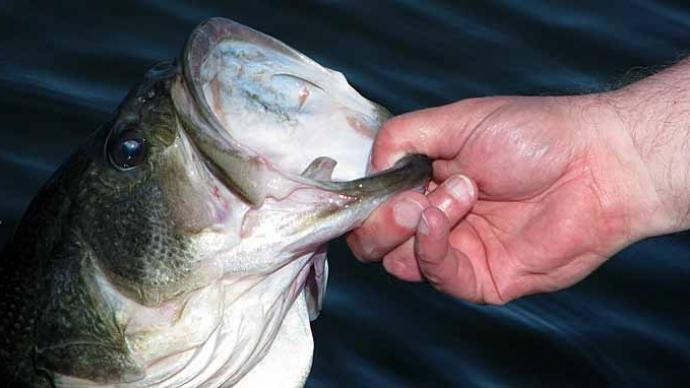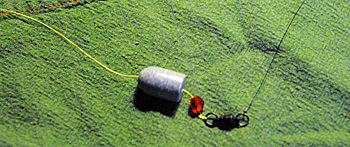
Talk to enough anglers, and you will eventually hear about the old "Ball and Chain" and how it won someone a tournament. That ball and chain is also known as the Carolina Rig. Some anglers do not like to fish it, calling it a tedious, do-nothing technique. It may be a do-nothing technique, but it is anything but boring when it is the technique that is catching fish when everything else is failing. The Carolina rig, or C-rig as it is also known, is one technique that allows for many variations. It allows me to use big, bulky baits, or small finesse baits. Depending on the situation and the mood of the fish, I can change up a few simple things and still catch them in a variety of areas.
The first thing to learn about a Carolina rig is how to set it up. It consists of a main line, a leader, and a few extras. I use 15-pound Seaguar Smackdown braid for my main line if I'm throwing it on a spinning setup with smaller finesse baits and 65-pound braid on my bait casting setups. On the baitcaster, I will have a heavier weight and likely a bulkier bait.
I always use monofilament for leaders. Some anglers use fluorocarbon for their leader, but to me, that defeats the purpose. The purpose of the Carolina rig is to get the bait to float up off the bottom as it comes through the water. Monofilament floats so that it will help the bait float. My go-to line will be different depending on the gear. I may use six- or eight-pound Sunline Defier monofilament on my spinning setups. For my bait casting set up, when I might be fishing around more heavy weeds and the like, I will use 12- or 14-pound Defier. The mono leader also has stretch, no matter what strength I am using. This helps with the hook set. When setting the hook with this rig, I reel until I feel the rod load up, and then use a sweeping hook set. If I were to set the hook with a snap hook set, like when fishing a jig, for instance, likely all that will happen is the weight will jump up off the bottom, and the fish may let go of the bait before I get a hook in him.
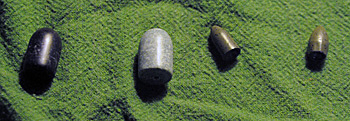
For the rest of the setup for the Carolina rig, I need a weight, a hook, a swivel, and a bead. I use glass beads because I like the sound better. The idea with the Carolina rig is that the lure is away from the weight – anywhere from 12 inches to 7 feet – letting the bait float up while the weight is running across the bottom. To me, the best choice for a Carolina weight is tungsten. Tungsten is a much better choice than lead because it is more sensitive and allows me to feel the bottom better. The weight I use depends on how deep I will be fishing. I want it to get to the bottom quickly, so I'll use the heaviest weight I think I can get away with. If I am in over 15 feet of water, I want a 1 oz. weight. From there, I move down in size, but I usually do not go below ½ oz. for the bigger rigs on my bait casters. I may go smaller on my finesse setup, down to ¼ oz.
The size of the hook will depend on the bait you are throwing. The size hook I select will allow me to Tex-pose the bait properly. The swivel will help keep any twist out of your line and is an essential link between the two lines. Therefore, I am always sure to use a high-quality ball-bearing swivel. The ball-bearing type alleviates line twist, making it a much better option than a regular swivel.
Rigging the C-rig is relatively straightforward. I know many anglers who use a lot of different knots. I am not one of them. A Palomar knot, when tied correctly, works well for most applications. First, I slide the weight onto the main line, then the glass bead. The bead protects the knot and makes noise against the weight. Because I use glass rather than plastic beads, I check the bead often to ensure it is not broken or chipped, which could cut the line.
From there, I work with the mono leader first. I tie one end of the mono to the hook and the other to the swivel. I tie the leader to the flat end of the swivel. Keeping the flat end down helps it come through cover better when it separates from the weight. Once the leader is set up, I use a Palomar knot to tie the main line (braid) to the other end. When I know I will be throwing this rig a good deal of the day, I make up a few leaders ahead of time so I do not have to spend time re-rigging on the water. I always experiment with the length of the leader to get it exactly right for what I'm fishing, so having a few in the boat with me lets me change lengths easily.
For cold water, my leader might be 12-18 inches. In the summer, it might be a couple of feet. When fishing near grass or heavy vegetation, it can go up to 6 feet. Long leaders such as that can be difficult to cast – it is more of a lob-type cast, as it would be with an A-rig. Especially for the longer leaders, a long rod is essential. But "long" means something different to everyone. I am pretty short at 5'3". About the longest rod I throw is 7'4". For taller anglers, a 7'11" might be a better choice.
Regarding reels, it depends a bit on what I'm throwing. For my finesse setups, I use a SPRO Vortex-E Series spinning reel. It works great for this application, and it is also inexpensive. This reel has a great drag on it and has held up to anything I throw at it. For my baitcasting reels, I use a Lew's BB1 Pro Speed Spool for most applications. A reel in the 6.1:1 to 6.4:1 is perfect for a Carolina rig for most baits. In some situations, I opt for a higher gear ratio. If I am throwing an MJ rig, for instance, or a swim bait, I may speed up to a Lew’s Super Duty reel with a 7.2:1 gear ratio. This allows me to cover water and work the bait faster, as it was meant to be.
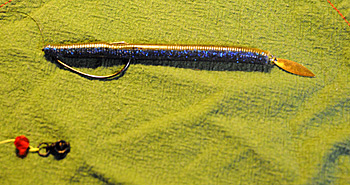
The next consideration is the bait to throw. I will throw any bait on a Carolina rig that I would typically throw on a Texas rig. The most significant difference is the ability to cover water with the Carolina rig. Creature baits such as craw imitations and brush-hog style baits are great for C-rigs. At times, a tube is a great bait, too. What I like about tubes on this rig is that I can put a small piece of Styrofoam or a piece of a cheap, disposable ear plug in the tube to help float it. Stick worms and even 10-inch ribbon-tail worms can be a good option in the hot summer. One variation on a stick worm is shown below. That is the MJ rig. I can create more flash in the water by screwing a small spinnerbait blade onto the back end of the worm. That is the reason for the higher speed reel for this option. I need to work it a bit faster to get the proper effect from the bait.
For finesse rigs, smaller baits are the key. Small craw imitations and finesse worms work well for this presentation. Also, if the wind is howling, casting a baitcaster with a 6-foot leader can be challenging. If the wind puts me out of my comfort zone, I will pick up a spinning reel. If I know the wind will blow, I will have another spinning set up ready for bigger tackle. I may move up to 12-14-pound mono, but I do not tend to go to larger diameter braid. For most spinning applications, I stick with 15-pound braid. I never go higher than 20-pound test for braid on my spinning reels.
The old "Ball and Chain" is more than just an old Janis Joplin tune. It is a great way to fish when all other options fail me. Yes, it is a do-nothing sort of rig. I cast it out and retrieve it with various cadences, but if doing nothing is what it takes to catch fish - I am okay with throwing it. It can float a lure over the edges of grass beds, on points, ledges, and humps. I will put the boat in deep water and fish down a point, for instance, but I will also put the boat in shallower water and fish the rig "uphill," from deep water to shallow. I will also fish it down the side of a ledge or point. A Carolina rig allows me to cover a lot of water and get a better mental picture of what is on the bottom where I find fish. It is an under-used rig, in my estimation. But it is one that I would recommend to anyone faced with a challenging day on the water.
Beckie Gaskill is an award-winning outdoor writer, life-long avid angler, and serves as a tournament director at several events in her home state of Wisconsin.


